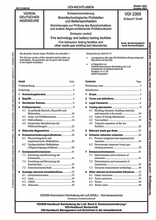Standards Worldwide
Standards Worldwide
Phone +49 30 58885700-07

Draft technical rule
VDI 2305:2023-10 - Draft
Emission control - Fire technology and battery testing facilities - Fire behaviour testing facilities and other waste gas emitting test laboratories
- German title
- Emissionsminderung - Brandtechnologische Prüfstellen und Batterieprüfstellen - Einrichtungen zur Prüfung des Brandverhaltens und andere Abgas emittierende Prüflaboratorien
- Publication date
- 2023-10
- Original language
- German, English
- Pages
- 112
- Publication date
- 2023-10
- Original language
- German, English
- Pages
- 112
Product information on this site:
Quick delivery via download or delivery service
Buy securely with a credit card or pay upon receipt of invoice
All transactions are encrypted
Short description
In Germany, well over 100 testing laboratories are operated, in which the following tests, among others, are carried out: tests to assess the fire behaviour of building components, building materials and other materials, to determine the fire resistance of building components or to prove the effectiveness of fire alarm and extinguishing systems; safety tests, e. g. on electrical energy storage systems, solar modules and fuel cells; tests within the framework of research and development projects. Depending on the test object/material and the test period, very large quantities of waste gas, containing very hazardous pollutants, are emitted during such tests. Exhaust gas volume flows of up to 50000 m³/h are known. Currently, there are no uniform specifications for the operation, the necessary reduction measures and the monitoring of such plants. In practice, there are very different solutions for such plants and their waste gas purification. In some cases, they are also operated without waste gas purification. For the first time, the standard specifies minimum requirements for the planning, construction, operation and monitoring of these test laboratories in order to avoid or reduce the environmental impacts that can emanate from these plants in accordance with the state of the art.
Content
ICS
13.040.40
Also available in
Loading recommended items...
Loading recommended items...
Loading recommended items...
Loading recommended items...
